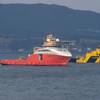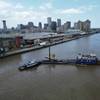Growth in Offshore Wind Parks is Good
Jack-up barge Endeavour ‘grows’ 19 meters
The increase in offshore activities means a lot of new work for the repair and conversion industry - and Shipdock is busily improving its position in this market: most recently with the lengthening of the GMS Endeavour’s four massive ‘legs’.
New orders are streaming in at Shipdock Amsterdam from the rapidly growing offshore wind energy activities on the Dutch and British North Sea shelf. Serious financial and political support from the two countries make it possible to develop new wind turbine parks in deeper waters. The offshore wind industry has to keep up with continually improving technology; 5 MW turbines have become commonplace, so offshore vessels and jack-up barges need to be equipped to install them at sea.
The current tendency to position in deeper waters and the forthcoming development of larger turbines (up to 10 MW) means that these support vessels need constant upgrades; with heavier cranes, more workspace on deck, heavier piling and hammering equipment - and longer legs to stand on.
In order to increase the working range of its vessel GMS Endeavour, GMS decided to lengthen the legs by an additional 19 metres. Allowing it to operate in water with depths of up to 60 meters.
Shipdock’s task is to mount the four extensions, each weighing 65 tonnes, on top of the existing legs and weld them into place. To achieve this a special 1.350t mobile crane has been temporarily installed on the barge platform.
The GMS Endeavour is ‘standing’ in elevated mode in order to make life easier for the team of fitters and welders, thus guaranteeing the most efficient working conditions. This also means that those working on the platform have to be flexible: when the wind gets too strong it is no longer safe to operate the lifts and the work-crew have to spend the night on the Endeavour.
Before commencing work, Shipdock and GMS carried out a full-scale risk assessment of the project. This has five identifiable major stages: 1) preparation at the quay, 2) lifting extensions and welding onto legs with crane assistance, 3) fitting and welding braces and span breakers, 4) painting and final fitting work and 5) demobilisation. Every stage is broken down into single jobs, and each job is analysed for possible failures and severity. The risk reduction measures are agreed upon and written into a protocol. It is obvious that a lifting operation on this scale involves a relatively high risk with severe consequences.
Fire is another high-severity risk – especially with welding in elevated mode. The welding is a very specialised job; controlled welding using S690 high-tension steel. Careful precautions have to be taken to create a wind-free space – allowing the welders to preheat the material.
Senior project manager Tjeerd Schulting is keeping a close watch on the Endeavour: “Both Shipdock and GMS are experienced in this field and we have agreed on a tight and secure schedule for the tasks. Workers have daily toolbox briefings before they go up. Good cooperation and understanding between GMS and Shipdock is the crucial factor for success on this project.”










